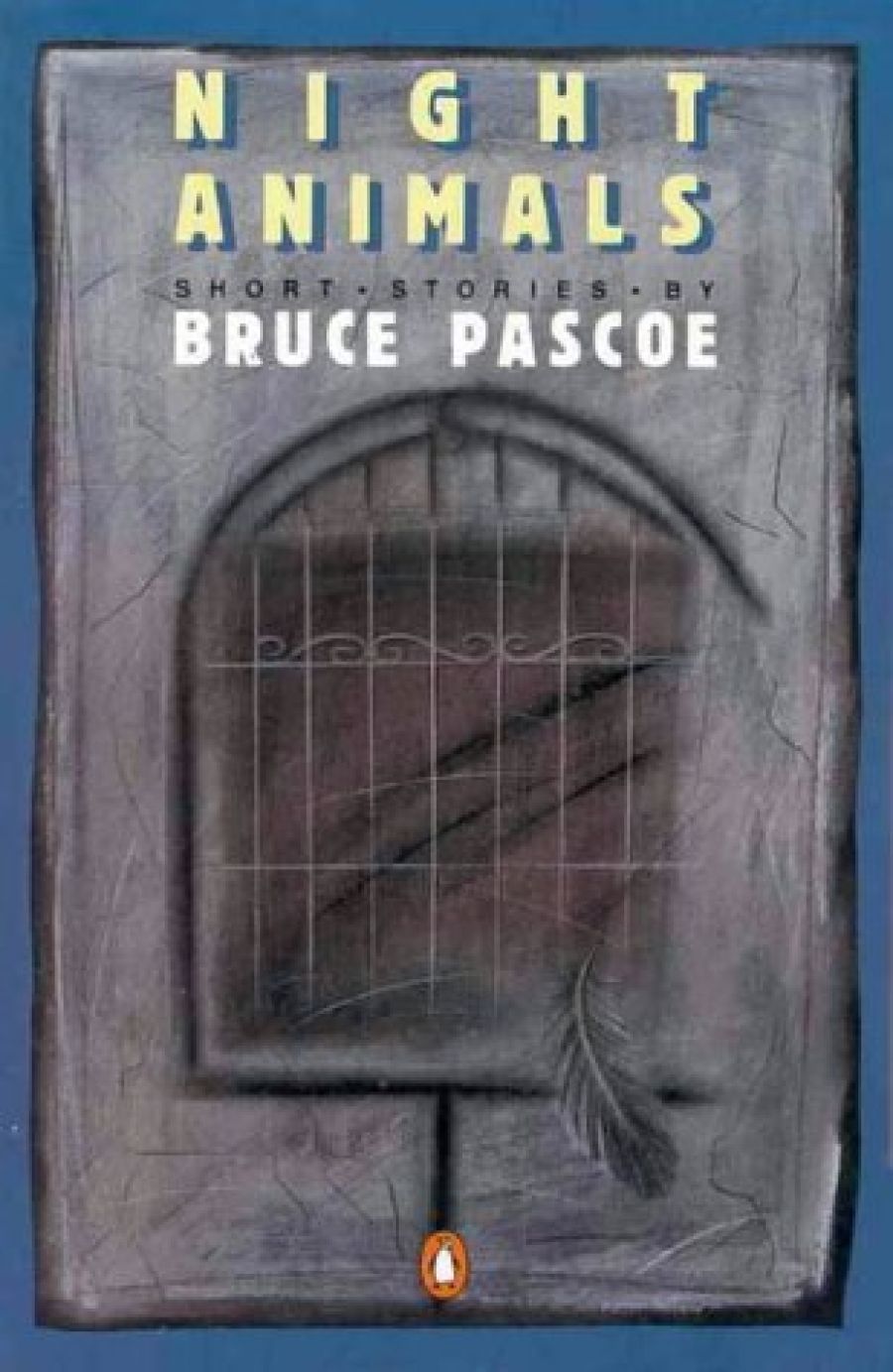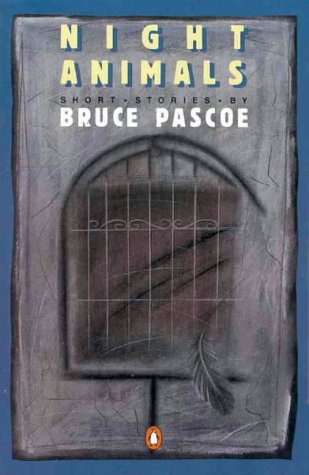
- Free Article: No
- Custom Article Title: Mythopoesis and the Post-Modernist Crocodile
- Review Article: Yes
- Article Title: Mythopoesis and the Post-Modernist Crocodile...
- Article Subtitle: ... and other critters of the masculine night
- Online Only: No
- Custom Highlight Text:
It’s a favour to no-one to call him (certainly never her) ‘a modern Henry Lawson’ – as the back cover of Bruce Pascoe’s collection proclaims – because of the large and difficult questions that are raised. What does the name ‘Henry Lawson’ mean? ‘The Loaded Dog’, or ‘Water Them Geraniums’? The writer of humorous stories about the bush where life is animated by a huge and comic spirit, or of ones about living in the bush that leave you feeling dismayed and chilled to the bone? And who is this epithet aimed at? For some Lawson is the face on the ten-dollar note; for others he’s the successful Australian writer who went to England and failed to make any impression, returned, and then lived long enough to mourn his own decline as a writer, ending his life as a miserable drunk; for still others he’s one of the first writers you read at school.
- Book 1 Title: Night Animals
- Book 1 Biblio: Penguin, 151 pp, $9.95 pb
- Book 1 Cover Small (400 x 600):

- Book 1 Cover (800 x 1200):

There is, though, another issue pinpointed by this collection of stories and it is suggested by these four characteristics. In the Winter issue of Island Magazine published last year, Gerard Windsor described what he saw as the plight of men who write fiction writing at a time when the writing, publishing, reviewing and reading of fiction is dominated by women. Setting the sillier sexist aspects of Windsor’s cri de coeur to one side, what emerges is the question of how the practice of storytelling shapes our ideas of masculinity, now, when the powerful stories are about women. If Windsor is a reliable spokesman, then men who write fiction are under some sort of pressure and so too are their stories. If David Brooks, in his piece in Meanjin, is also a reliable spokesman then men writing fiction have felt the need to respond to the pressure of pen-wielding women – though they may not want to adopt Brook’s position of having been taught a lesson. In this context, Pascoe’s collection reads like an answer and his answer takes the form of mythopoesis: he retells stories about men and their lives in an attempt to discover a new myth of masculinity. AJI of the familiar themes are here: growing up, sons and fathers, going to war, the war with women, mateship, betrayal... all the animals in the nights of a man’s life, I guess.
But making this new myth is hard yakker. There are at least two problems: one technical and the other aesthetic. The technical one is to accommodate the need for largeness within the confines of the short story, for the characters and emotions of myth are larger and simpler than life. The aesthetic one is that posed by retelling the familiar to an audience who can spot repetition at fifty paces and for whom parody is a way of life. Paul Hogan, his crocodile, and post-modernism have a lot to answer for. Pascoe is an ambitious writer and it’s to his credit that he tapes up his gloves and has a crack at both problems.
His solution to the first problem is to write a story that stretches the yam, that standby of Australian fiction, in the direction of what’s now called short prose fiction. So the first story ‘Thylacine’ is told by a narrator who sounds like someone telling a story. It is punctuated by comments that sketch in its teller for us: ‘Clarrie was like that,’ the narrator says at one point, and ‘He didn’t tell Clarrie, you couldn’t, but he knew some poems by heart,’ at another. But at the same time the story is starred by metaphor and allusion that illuminate the story. So that it is by moonlight, ‘fierce white light,’ that we read the narrator’s final comment, ‘He was just a bushman.’
The second problem is tricky. But ‘Funny Man’ is a canny solution. This is about the comedian who comes to a town, like all the other towns, and tells the same jokes to the same crowd of men wearing Old Spice and women with coiffures. Bobby McLean, when they finally get his name right, does battle with the microphone, the young smartarses, the middle-aged footy club officials, the predatory woman, and winds up ‘everyone’s favourite’. He is a short man with crossed eyes and he’s a man from the city come to make a buck in the bush. At the end of the story, Bobby is the only passenger on a rattling train that will take him ‘Another hundred miles of dry country track and three lonely hours of clackety clack.’ The cliched rhythm of this final sentence is the perfectly controlled end of a steady unrelenting accumulation of worn-out phrases and tired people and familiar scenes. ‘Funny Man’ is a story, in other words, about having been there and done that. And its punch is that facing up to the truth of it all doesn’t make any real difference; ‘nobody noticed’. This story makes repetition and parody into the story itself while the artifice acknowledges the edges of the funny man’s life. The story’s claim is that writing makes somebody notice.
The stories don’t always work. ‘Splitter’ is the too short story of a timber feller who has an accident up in the bush and his only remains are a pile of dried out bones guarded by his faithful black dog who goes feral. This story suffers by comparison with Eric Rolls’s fine version of the same tragedy. In ‘Splitter’ the story is too thin to avoid being pastiche that ends in bathos; and, from the narrator’s tone, this is not the idea at all.
And the old song about sex sometimes sounds tinny. Usually the problem is with the language: too much of the ‘curve of breast and hip’; too much ‘trembling, shivering with rippling spasms’. There’s a lot of ‘her breast’ and not much of his anything; though at one point ‘his vulnerability’ tingles. After Frank Moorhouse and David Malouf this sort of coyness is pointless. At other times, sexual ideology and racial politics become confused. ‘Flour For Your Grave’, a story about blacks and whites, tells of an exchange between the two parties: poisoned flour for a family killing. The story depends upon its explicit moral vision: the whites’ fear and ignorance causes the effect of the blacks’ retaliation. It’s a simple and lucid equation. But one of the final images has a settler’s wife speared to the door with a look of surprise on her face. Since the story focusses on the acts and emotions of the men, both black and white, the wife becomes an innocent victim and in the story’s moral equation this is simply beside the point. The wife parallels neither the brutality of the white men nor the vulnerability of the blacks, and so her death becomes merely a distraction. In the final sentences the story reaches for an overt didacticism that collapses into cliche: ‘The wind is old, older than the black man, or the white man. The wind forgets nothing and seeks to remind us all.’
There are twenty-two stories in Night Animals and as a collection they are varied and exploratory. A number of the stories - two about a character called Cobber; ‘Work-horses’ about a young boy working with his grandfather to help feed the family in the Depression; ‘Friday Night’ about a family coping with the death of a favourite son killed in Vietnam; ‘That’s What Friends Are For’ about mateship and betrayal; and ‘Soldier Comes Home’ about a soldier who comes back from Vietnam – read like the episodes of a larger work, about a bloke who ...
These stories demonstrate that Pascoe has found a territory and has the skills he’ll need to work over the ground. Others show that Pascoe can tell different kinds of stories. ‘Gravity and Levity’ has a neatly sustained veneer of urbane chic. ‘Dreaming’ owes something to Gerald Murnane – but, in bringing the metaphysical into play, the story strengthens the collection.
In the end, I’m not sure that I was – what is it that a myth does? Convince? Overwhelm? Explain? Perhaps the task of a myth is to make us remember. The story I remember, the one I went back to reread, is not about the bush or bravado or betrayal. ‘Sirens’ is about the urban working class: a boy comes back to visit his mum who cleans a ‘boarding house’ in St Kilda. It is the least explicit story in the collection; full of risks and kitsch mementos like the little glass dome with the Opera House inside that Kevin gives to his mum. The story is made up of remembered smells, familiar raw edges, things crumbling but still in place; and throughout the story there’s an eroticism that is shrewdly caught between loss and insistence, between masculinity and femininity. Here Pascoe’s concern for a strident masculine voice is finally mastered and allows him a tenderness that doesn’t sound hollow. ‘Sirens’ is a story that goes beyond the myths of the bush and bravado and betrayal.


Comments powered by CComment